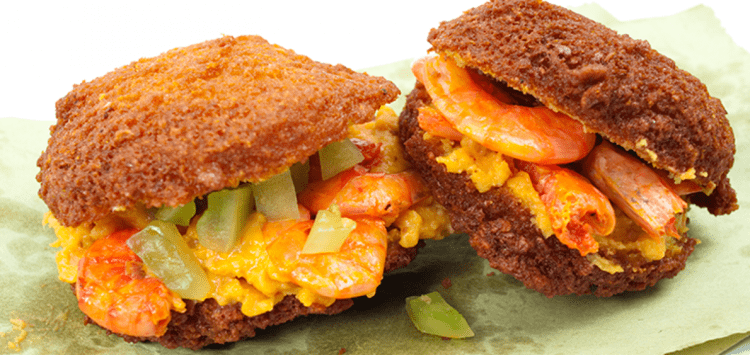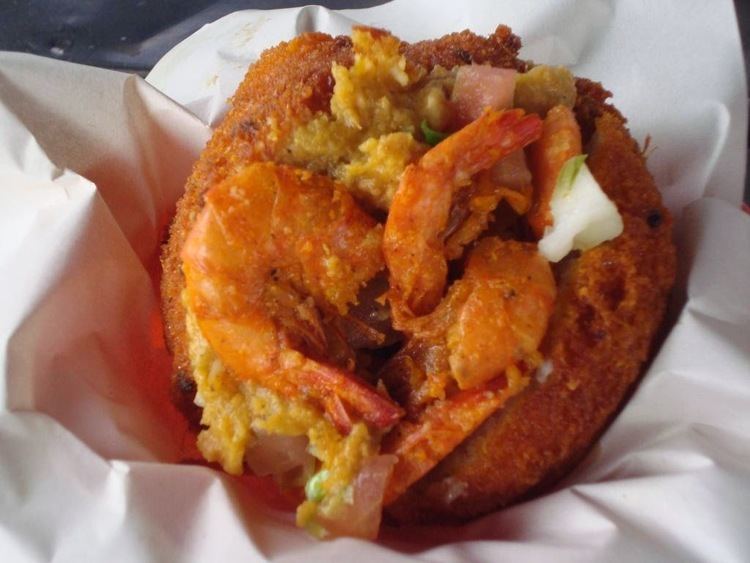Alternative names Akara Place of origin West Africa | Course Breakfast | |
Region Bahia, Salvador, Nigeria, Ghana, Gambia, Benin, Mali, Togo Main ingredients Pepper, Ground black-eyed peas, Salt, Onions Similar Vatapá, Caruru, Moqueca, Feijoada, Moin moin | ||
Acarajé ([akaɾaˈʒɛ]) or (Yoruba: àkàrà) is a dish made from peeled beans formed into a ball and then deep-fried in dendê (palm oil). It is found in West African and Brazilian cuisines. The dish is traditionally encountered in Brazil's northeastern state of Bahia, especially in the city of Salvador. Acarajé serves as both a religious offering to the gods in the Candomblé religion and as street food. The dish was brought by slaves from West Africa, and can be found in various forms in Nigeria, Ghana, Togo, Benin, Mali, Gambia, Sierra Leone.
Contents

Acarajé is made with cooked and mashed black eyed peas seasoned with salt and chopped onions molded into the shape of a large scone and deep-fried in palm oil in a wok-like pan in front of the customers. It is served split in half and stuffed with vatapá and caruru – spicy pastes made from shrimp, ground cashews, palm oil and other ingredients. A vegetarian version is typically served with hot peppers and green tomatoes. Acarajé can also come in a second form called Abara, where the ingredients are boiled instead of deep fried.

Etymology

Acarajé is a word derived from the Yoruba language. Àkàrà is a generic word meaning "bread" or "pastry", or the dish itself. The Brazilian term "acarajé" derives from either the Yoruba word combinations "àkàrà" (bread) and "onje" (food), or "àkará" (a round pastry) and "je" (to eat).
History

Akara (as it is known in southwest and southeast Nigeria) a recipe taken to Brazil by the slaves from the West African coast. It is called "akara" by the Yoruba people of south-western Nigeria, "kosai" by the Hausa people of Nigeria or "koose" in Ghana and is a popular breakfast dish, eaten with millet or corn pudding. In Nigeria, Akara is commonly eaten with bread, Ogi (or Eko), a type of Cornmeal made with fine corn flour.

Akara plays a significant role in the Yoruba culture, as it was specially prepared when a person who has come of Age (70 and Above) dies. It was usually fried in large quantity and distributed across every household close to the deceased. Akara also used to be prepared in large as a sign of victory, when warriors came back victorious from war. The women, especially the wives of the Warriors were to fry Akara and distribute it to the villagers.
In Candomblé

Acarajé is a fixture in the Afro-Brazilian religious traditions of Candomblé. Although it is the ritual food of the goddess Iansã, the first acarajé in a candomblé ritual is offered to Exu. Acarajé used in Candomblé ritual have no filling. They vary in size based on their offering to a specific deity: large acarajé are offered to Xangô, smaller sizes to female deities, and small fritters to offer to Erês, or child spirits.

Acarajé sold on the street are variously made with fried beef, mutton, dried shrimp, pigweed, fufu osun sauce, and coconut. Today in Bahia, Brazil, most street vendors who serve acarajé are women, easily recognizable by their all-white cotton dresses and headscarves and caps. The first appeared in Bahia selling acarajé in the 19th century. The city now has more than 500 acarajé vendors. The image of these women, often simply called baianas, frequently appears in artwork from the region of Bahia. Acarajé, however, is available outside of the state of Bahia as well, including the streets of its neighbor state Sergipe, and the markets of Rio de Janeiro.
